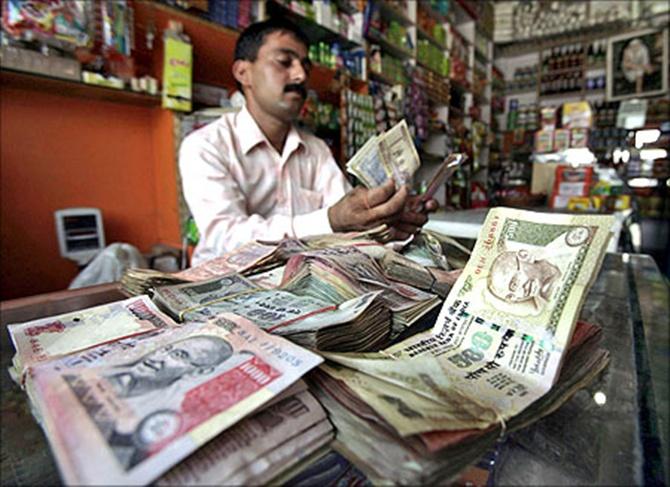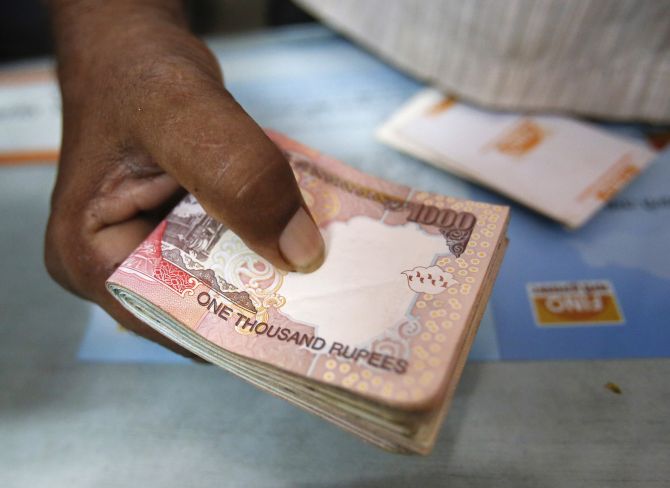Photographs: Courtesy, PIB Malini Bhupta in New Delhi
Real fiscal consolidation and reducing the subsidy burden are the two most critical issues the markets will watch for in finance minister Arun Jaitley's Budget.
However, to slay the dragon called fiscal deficit, the government either needs to augment its revenues or cut expenditure.
Economists believe Jaitley does not have any room left to cut either expenditure or subsidies.
Be prepared for a disappointing Budget.
For one, Jaitley won't be able to slash expenditure as predecessor P Chidambaram did to bring down the deficit from 5.7 per cent of the gross domestic product in FY12 to 4.5 per cent in FY14.
Please . . .
Please click here for the Complete Coverage of Budget 2014 -15
Don't expect fireworks from FM on fiscal deficit
Image: A breakdown of the government's Rs 15.9-lakh crore (Rs 15.9-trillion) spending shows that 24 per cent of this is spent on interest payments, 16 per cent on subsidies, 13 per cent on salaries, 13 per cent on defence and 14 per cent on others.Photographs: Reuters
Very little of the expenditure is discretionary.
A breakdown of the government’s Rs 15.9-lakh crore (Rs 15.9-trillion) spending shows that 24 per cent of this is spent on interest payments, 16 per cent on subsidies, 13 per cent on salaries, 13 per cent on defence and 14 per cent on others.
Education, health and rural infrastructure comprise the other areas. It cannot afford to cut further on any of these.
Credit Suisse says: “There is also limited room for fiscal manoeuvre, as the volatile corporate taxes are 34 per cent of all taxes (versus 11 per cent in the US), and only a small fraction of spending is discretionary.
Please . . .
Please click here for the Complete Coverage of Budget 2014 -15
Don't expect fireworks from FM on fiscal deficit
Image: The government has managed its finances by deferring the current year's subsidy payout to the next financial year.Photographs: Reuters
The total subsidy bill in FY15, according to the interim Budget, is estimated to be Rs 2.6 lakh crore (Rs 2.6 trillion), of which food subsidy will account for 45 per cent of the total subsidy burden.
Oil subsidies will account for 25 per cent of the total budgeted subsidy bill at Rs 63,400 crore (Rs 634 billion).
Interestingly, Rs 35,000 crore (Rs 350 billion) is a spill-over from the previous financial year.
The government has managed its finances by deferring the current year's subsidy payout to the next financial year.
Please . . .
Please click here for the Complete Coverage of Budget 2014 -15
Don't expect fireworks from FM on fiscal deficit
Image: Deferring subsidy and other payouts has also pushed the current year's fiscal deficit to 46 per cent of the full year estimate.Photographs: Reuters
Another 26 per cent is accounted for by fertiliser subsidies.
Deferring subsidy and other payouts has also pushed the current year's fiscal deficit to 46 per cent of the full year estimate.
If the government wants to take a bold decision, it would have to adjust the spillover from previous years by taking a one-time hit and opt for a high deficit in the current year instead of the budgeted 4.1 per cent.
Bank of America Merrill Lynch's India economist Indranil Sen Gupta says the spillover has already been funded by a drawdown of the Center's surplus with the Reserve Bank of India.
However, the finance minister can still opt for a higher fiscal deficit of 4.5 per cent to step up capex and borrow an additional Rs 40,000 crore (Rs 400 billion) to fund it.
Please click here for the Complete Coverage of Budget 2014 -15






article